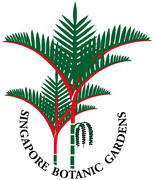Nomenclature
Accepted name/Authority/Place of publication:
Argyreia bifrons Ooststr., Blumea 5: 362. 1943.
Description
Habit:
Stems twining; young parts densely pubescent to farinose.
Leaves:
Leaves ovate, 5–10 by 3.5–6.5 cm; base truncate to emarginate, apex acute to shortly acuminate; upper surface densely and appressedly gray or olive-green sericeous, lustrous, lower surface densely and shortly crisped-tomentose, paler and dull; midrib and 10–14 lateral nerves on either side prominent beneath; petioles short, 1–2 cm, densely and shortly tomentose.
Inflorescences:
Inflorescence peduncle much exceeding the petiole, 6–10 cm, angular or sulcate when dry, shortly tomentose, umbellately cymose at the apex, many-flowered. Pedicels (of young flowers) up to 5 mm. Bracts oblong to narrowly spathulate, densely short-pubescent to tomentose on both surfaces, 6 mm long, caducous.
Flowers:
Flower sepals unequal, densely pubescent to tomentose on both sides; 2 outer ones oblong, obtuse or slightly emarginate, 8–9 mm long, sepal 3 a little shorter and narrower, obtuse, ca 6.5 mm long, 2 inner sepals broadly elliptic, obtuse, 5 mm long. Corolla funnel-shaped (only young flowers seen), bright violet, the midpetaline bands sericeous, for the rest glabrous. Filaments pilose at the base. Ovary glabrous, 2-celled.
Fruits:
Fruit unknown.
References:
Ooststroom, S.J. van & R.D. Hoogland, Convolvulaceae inFlora Malesiana 4: 388–512. 1953.
Biogeography, Ecology and Natural History
Distribution:
LesserSunda Islands (Lombok).
Ecology:
Twining
on trees and shrubs; the only specimen known at 5–10 m elevation.
Other information
General comments:
The young flowers of the type specimen do not permit a closeexamination of the corolla, stamens, and pistil.
Authorship for webpage
Editor:
G. Staples
Contributors:

Classification:

Add new comment